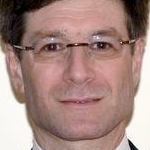 First, tell us a bit about yourself (hometown, current locale, family, hobbies, community involvement?).
First, tell us a bit about yourself (hometown, current locale, family, hobbies, community involvement?).
Except for four years in Philadelphia and two years overseas, the Boston area has always been my home. My wife, Irina, and I have two sons—Jeff, 25, and Aaron, 13. I enjoy most kinds of music — especially early music, for which Boston is a great city—and I’ve started to play oboe again in a parent/teacher wind ensemble at my younger son’s school. In summers, I hike and sail (cruising and racing), and in winters I ski. I read in any free time I can find.
Describe some of your responsibilities, and how you or your organization fit into the scholarly communications web.
Since 1993, Inera has helped scholarly publishers navigate the shift from print to electronic publishing, and from ePublishing version 1 to version “n”. We do this through a combination of consulting services, software products, and involvement in synergistically related industry activities. For example, our work with CrossRef, the NLM DTD, and other NISO standards all help us to bring better solutions to customers, and explain how their workflows can best incorporate these standards. Inera’s expertise in software development and quality assurance ensures that we provide robust applications blending the best of technology and publishing.
I’ve been Inera’s CEO since 1997 and I’m involved in all aspects of the company. I manage the business side of Inera, but my original background is software development, and I use this expertise to guide the development of our eXtyles product family. My most important roles are helping Inera’s customers and coordinating the incredibly creative team of people who work at Inera.
What career path led to your current position?
My career is a double-helix of intertwined interests in publishing and technology. I first learned computer programming at high school in the early 70s, but then I majored in English and History at the University of Pennsylvania because I wanted to be a photojournalist who could also write as well as take pictures. These interests mixed at the Penn daily newspaper when I helped select a new composition system and a computer “front end” to replace 3 paper-tape keyboards (my first workflow transition project).
A word processor for Chinese built on an Apple II in 1980 was my first professional software project. From 1984 to 1997, I worked for an outsource software development firm (when that still meant on-shore) building products, many of which were publishing related, for companies like Microsoft, Word Perfect, and Houghton Mifflin. I moved to Inera as part of a life/family change in 1997.
Where do you see scholarly communications heading, and what new directions interest you most?
The economic model of scholarly publishing is changing rapidly. As an author, I want my own research to be read by the largest number of people, and open access makes my work accessible. I think more and more scholars are willing to pay for publication to achieve broad dissemination of their work. When author-pays is combined with declining library budgets, the cost of publication will be borne increasingly by research funders rather than libraries.
Digitization will have a big impact on copyright. When the marginal cost to reproduce content drops to near zero, it becomes much harder to prevent piracy. Content consumers can and will copy freely anything that they decide is too expensive. Music distribution is radically different than it was twenty years ago, and distribution of traditional print products will change just as much in the next twenty years. I think readers will become more price sensitive to content quality, with micro-payments for content fragments (single articles, or even single graphics) becoming commonplace. When songs are 99 cents, few buy an album. The same will happen to the written word.
Anyone who wants to think about the future of scholarly communications should read Elizabeth Eisenstein’s book “The Printing Press as an Agent of Change” (Cambridge University Press). Published in 1979, just before the computer revolution, Eisenstein explores the broad impact of the printing press. Reading her work in a digital world is thought provoking about the changes we’re experiencing now and the role print will play (or not) in the future.
What are some of the surprises/obstacles that you’ve encountered during your career?
I’m always amazed at how a small and talented team working closely together can develop really cool new ideas and products. I love sharing ideas with others to build something that is better than any single person on the project could have built themselves. When I look back on all my favorite projects, this is a strong common thread.
I think the biggest surprise has been seeing how the power of the Internet can allow a small company to be a global business. If someone had told me ten years ago that eXtyles would be used in 20 countries by 2010, I would have laughed.
The biggest obstacle is not unrelated. The Internet has brought us a 24-7 world that requires immediate attention. It’s often difficult to set up boundaries between business and personal life. However, I always disconnect on vacations (no email, sometimes no phone access) so I can really recharge.
What advice would you give to people interested in a career in scholarly communications? What new roles or opportunities do you see emerging in the field?
Get a liberal arts degree. A broad-based education and a love of learning will have greater long-term benefit than a pre-professional degree designed to get you your first job. If there’s a critical role emerging, it’s people who can fuse innovative new ideas with actual technological implementation. Many people are good at one or the other, but those who can master leadership in both publishing and technology will thrive in the fast-paced, changing world of communications.
I consider myself very lucky to be in publishing right now—the field is changing more than at any time since Gutenburg. Anyone who is involved today can help to build the future of publishing and has the potential to have a really long-term impact.
Profiled January 2011

